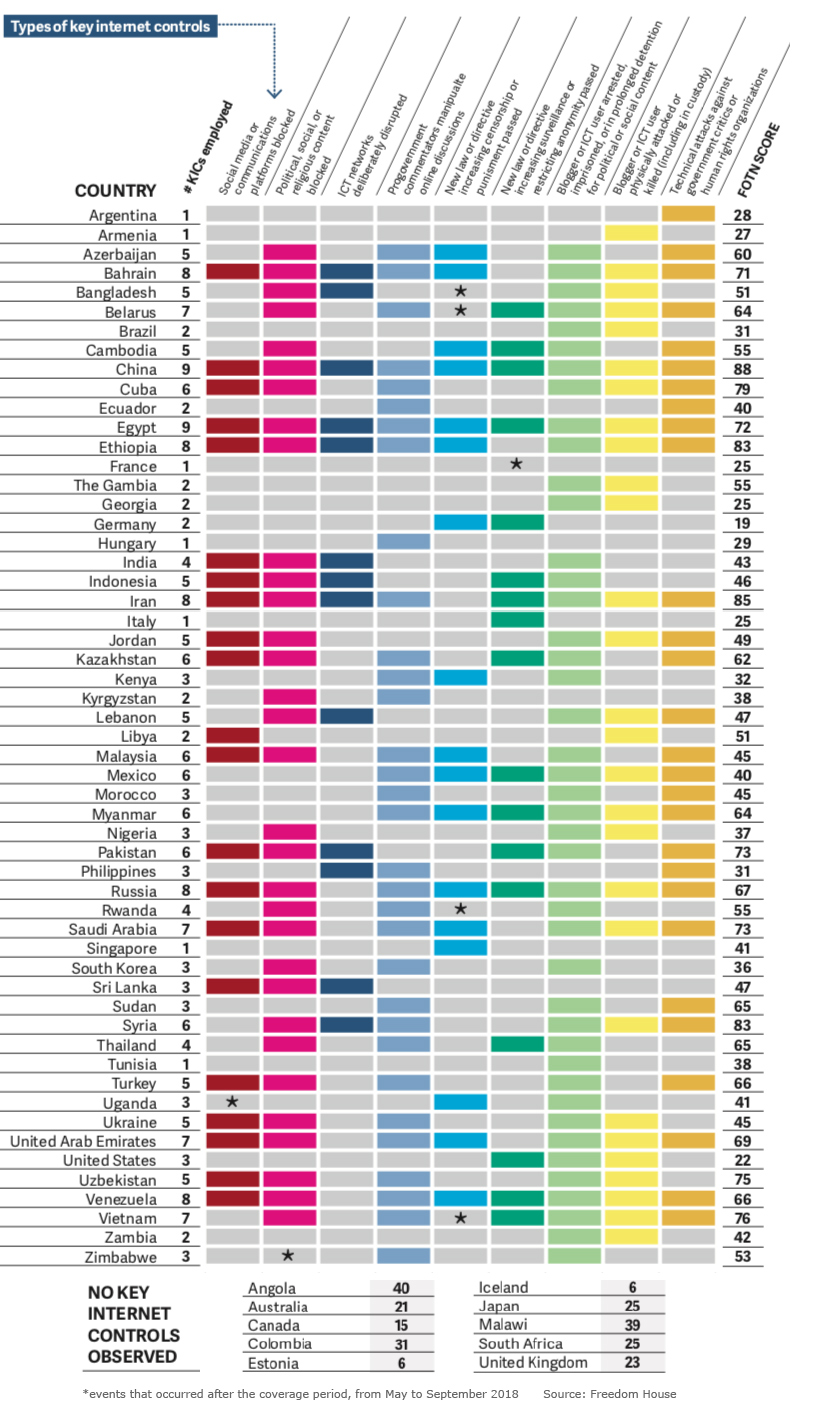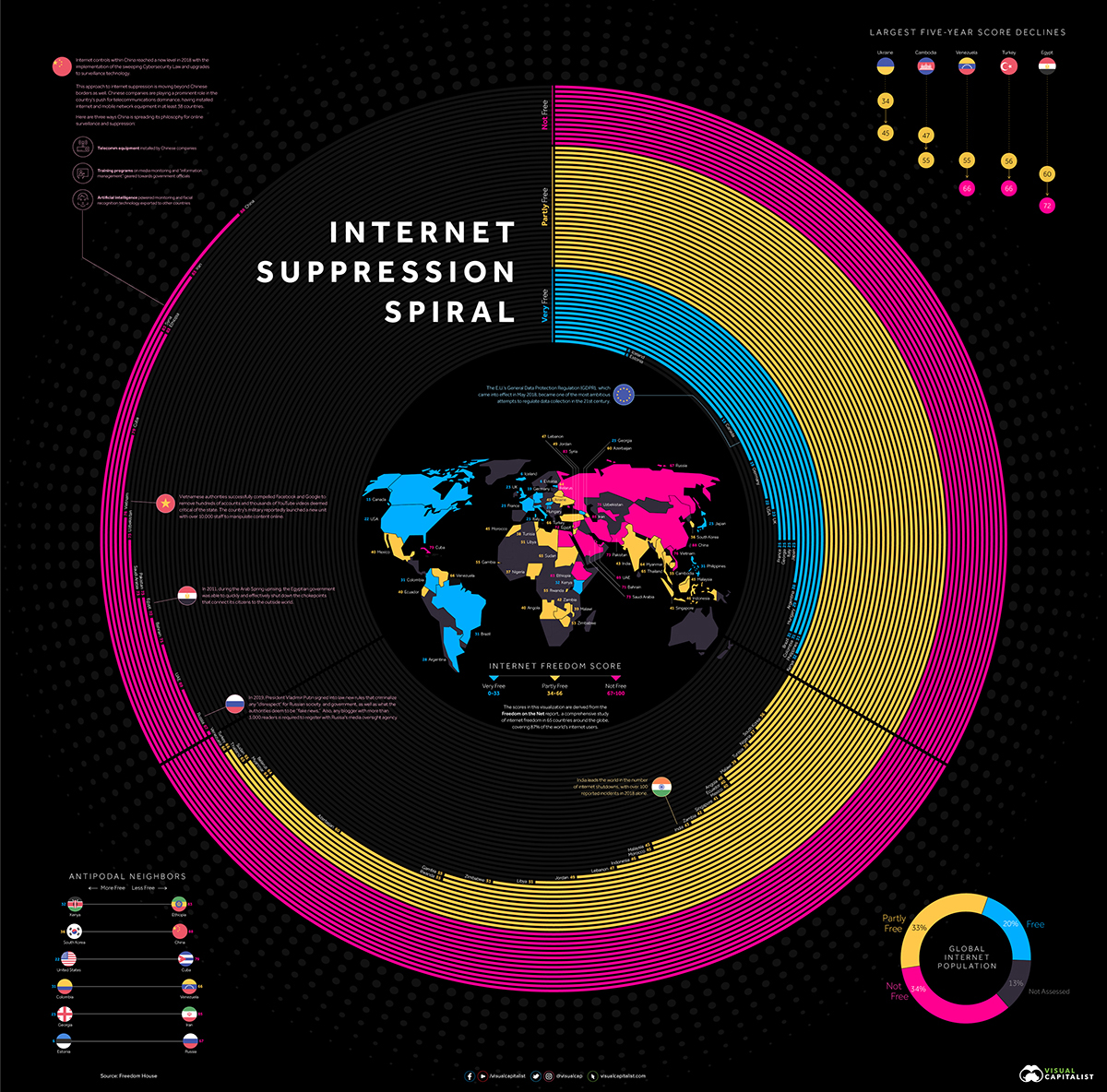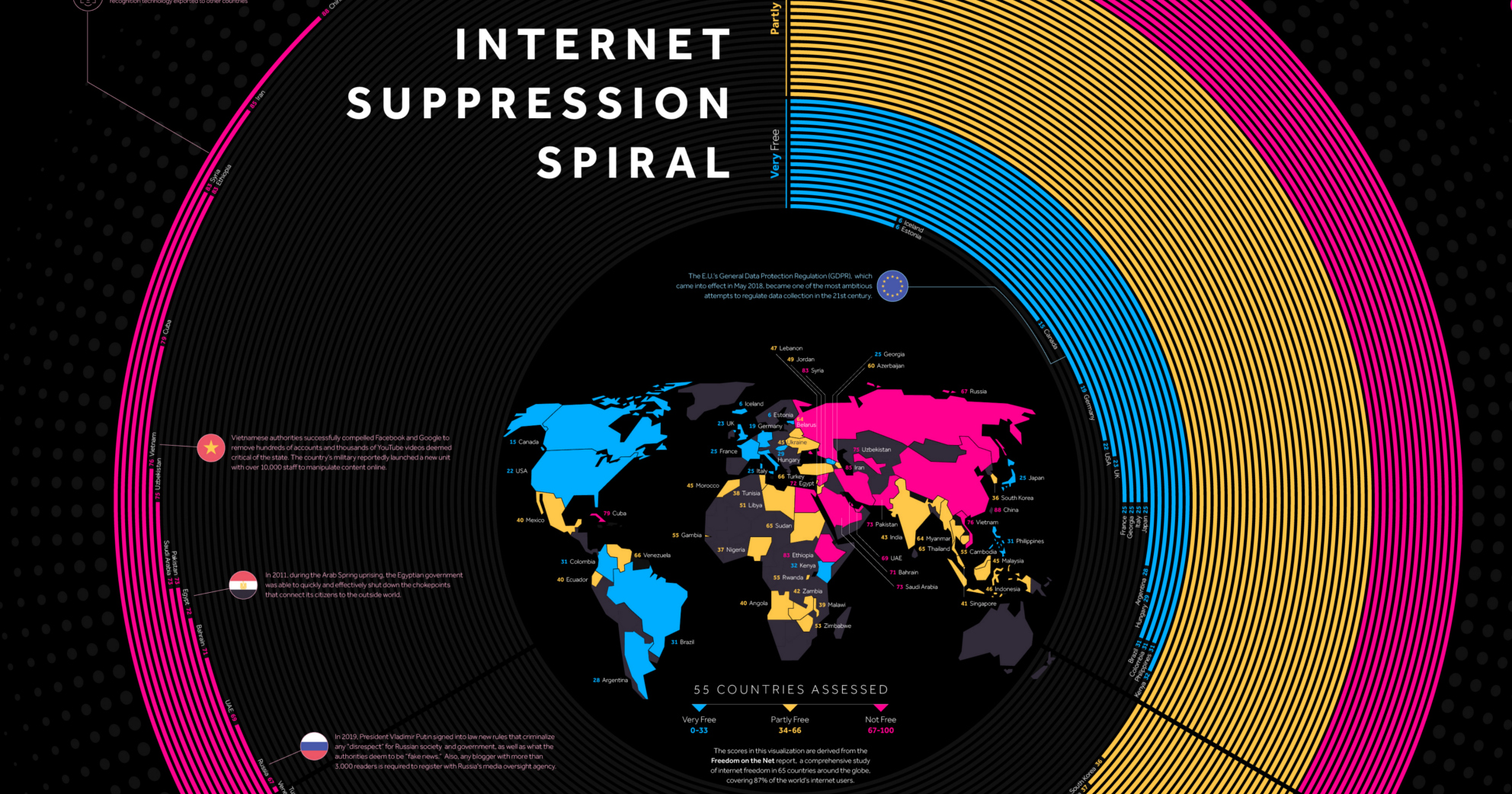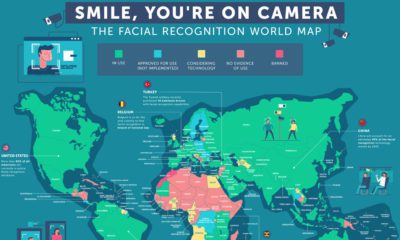Technology
Visualizing Internet Suppression Around the World
View the full-size version of the infographic
Visualizing Internet Suppression Around the World
View the full-size version of the infographic by clicking here
When people think of freedom, they often think it in the physical sense, such as the ability to act and behave in certain ways without fear of punishment, or freedom of movement within one’s country.
When a nation chooses to restrict freedom in the physical world, the results are often hard to ignore. Protests are met with tear gas and rubber bullets. Road checks pop up along transportation routes. Journalists are detained.
In the digital world, creeping control often appears in more subtle ways. Personal data is accessed without us knowing, and swarms of suspiciously like-minded accounts begin to overwhelm meaningful conversations on social media platforms.
The Freedom on the Net Report, by Freedom House, breaks internet suppression down into a number of elements, from content filtering to detention of online publishers. Here’s how a number of countries around the world stack up:

According to the report, internet freedom around the world has been falling steadily for eight consecutive years. Today’s graphic is an international look at the state of internet freedom.
First World Problems
At its best, the internet allows us to seek out information and make choices free from coercion or hidden manipulation. Even in countries with relatively open access to information this is becoming increasingly difficult.
In Western countries, internet suppression often rears its head in the form of misinformation and excessive data collection. The Cambridge Analytica scandal was a potent example of how the vast amounts of data collected by platforms and third parties can be used to manipulate public opinion.
The backlash to this data collection by tech companies also produced one of the most promising developments in the past year – the EU’s General Data Protection Regulation (GDPR). While the regulations are not applicable to government and military entities, it does create a pathway to increased transparency and accountability for companies collecting user data.
Control Creep
Around one-third of the people in the world live in countries that are considered “partly free”.
For most users, access to online information may not look too different from the internet experience in Iceland or Estonia, but there are creeping controls in specific areas.
In Turkey, Wikipedia was blocked and social media companies were compelled to censor political commentary. The country had one of the largest declines in internet freedom in recent years.
In Nigeria, data localization requirements have been enacted. This follows the lead of places like China and Vietnam, where servers must be located within the country for “the inspection, storage, and provision of information at the request of competent state management agencies.”
Access Denied
For many people around the world – particularly in Asia – accessing information online is a fundamentally different experience. Content published by an individual can be monitored and censored, and online activity that would be considered benign in Western countries can result in severe real-world consequences such as imprisonment or death.
As today’s data visualization vividly illustrates, China has by far the most restricted internet of the 65 countries covered in the report.
Network operators in the country are obligated to store all user data within the country (which can be accessed by governmental bodies), and are required to immediately stop the transmission of “banned content”. The country is also further cracking down the use of VPNs, which are used to circumvent China’s Great Firewall.
Of course, China is not alone in the desire to implement tight controls over online access. Many places, from Vietnam to Ethiopia, are eager to embrace the “China Model”. The country, which is aggressively ramping up its influence around globe, is more than happy expand its influence through exporting models of governance to new technologies, such as facial recognition.
Meanwhile, in Russia, the popular messaging app, Telegram, was blocked due to its refusal to allow the country’s security service access to encrypted data. This example highlights a growing dilemma faced by tech companies operating internationally – acquiesce to government demands, or lose access to huge markets.
A Tale of Two Internets
Today, there are two prodominant flavors of internet on the menu – the Silicon Valley offering dominated by major tech companies, and the top-down, state-controlled version being spread in earnest by Beijing. It would be a mistake to believe that the former is the clear choice for jurisdictions around the world.
In many countries in Africa, communications infrastructure is still being built out, so assistance from Chinese companies is accepted with open arms.
Our Chinese friends have managed to block such media in their country and replaced them with their homegrown sites that are safe, constructive, and popular.
– Edwin Ngonyani, Tanzania’s Deputy Minister of Works, Transport and Communication
Even though the internet is now three decades old, its form is still evolving. It remains to be seen whether the divergence between free and not free jurisdictions continues to grow.
Technology
Visualizing AI Patents by Country
See which countries have been granted the most AI patents each year, from 2012 to 2022.

Visualizing AI Patents by Country
This was originally posted on our Voronoi app. Download the app for free on iOS or Android and discover incredible data-driven charts from a variety of trusted sources.
This infographic shows the number of AI-related patents granted each year from 2010 to 2022 (latest data available). These figures come from the Center for Security and Emerging Technology (CSET), accessed via Stanford University’s 2024 AI Index Report.
From this data, we can see that China first overtook the U.S. in 2013. Since then, the country has seen enormous growth in the number of AI patents granted each year.
| Year | China | EU and UK | U.S. | RoW | Global Total |
|---|---|---|---|---|---|
| 2010 | 307 | 137 | 984 | 571 | 1,999 |
| 2011 | 516 | 129 | 980 | 581 | 2,206 |
| 2012 | 926 | 112 | 950 | 660 | 2,648 |
| 2013 | 1,035 | 91 | 970 | 627 | 2,723 |
| 2014 | 1,278 | 97 | 1,078 | 667 | 3,120 |
| 2015 | 1,721 | 110 | 1,135 | 539 | 3,505 |
| 2016 | 1,621 | 128 | 1,298 | 714 | 3,761 |
| 2017 | 2,428 | 144 | 1,489 | 1,075 | 5,136 |
| 2018 | 4,741 | 155 | 1,674 | 1,574 | 8,144 |
| 2019 | 9,530 | 322 | 3,211 | 2,720 | 15,783 |
| 2020 | 13,071 | 406 | 5,441 | 4,455 | 23,373 |
| 2021 | 21,907 | 623 | 8,219 | 7,519 | 38,268 |
| 2022 | 35,315 | 1,173 | 12,077 | 13,699 | 62,264 |
In 2022, China was granted more patents than every other country combined.
While this suggests that the country is very active in researching the field of artificial intelligence, it doesn’t necessarily mean that China is the farthest in terms of capability.
Key Facts About AI Patents
According to CSET, AI patents relate to mathematical relationships and algorithms, which are considered abstract ideas under patent law. They can also have different meaning, depending on where they are filed.
In the U.S., AI patenting is concentrated amongst large companies including IBM, Microsoft, and Google. On the other hand, AI patenting in China is more distributed across government organizations, universities, and tech firms (e.g. Tencent).
In terms of focus area, China’s patents are typically related to computer vision, a field of AI that enables computers and systems to interpret visual data and inputs. Meanwhile America’s efforts are more evenly distributed across research fields.
Learn More About AI From Visual Capitalist
If you want to see more data visualizations on artificial intelligence, check out this graphic that shows which job departments will be impacted by AI the most.
-

 Mining1 week ago
Mining1 week agoGold vs. S&P 500: Which Has Grown More Over Five Years?
-

 Markets2 weeks ago
Markets2 weeks agoRanked: The Most Valuable Housing Markets in America
-

 Money2 weeks ago
Money2 weeks agoWhich States Have the Highest Minimum Wage in America?
-

 AI2 weeks ago
AI2 weeks agoRanked: Semiconductor Companies by Industry Revenue Share
-

 Markets2 weeks ago
Markets2 weeks agoRanked: The World’s Top Flight Routes, by Revenue
-

 Countries2 weeks ago
Countries2 weeks agoPopulation Projections: The World’s 6 Largest Countries in 2075
-

 Markets2 weeks ago
Markets2 weeks agoThe Top 10 States by Real GDP Growth in 2023
-

 Demographics2 weeks ago
Demographics2 weeks agoThe Smallest Gender Wage Gaps in OECD Countries





